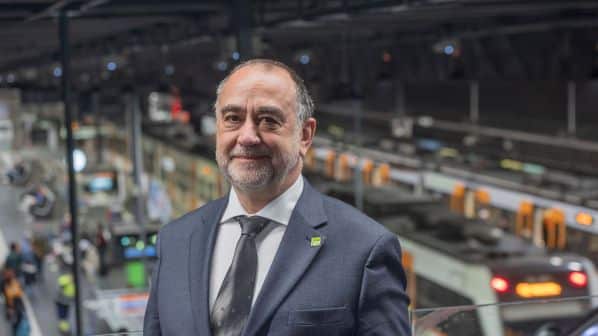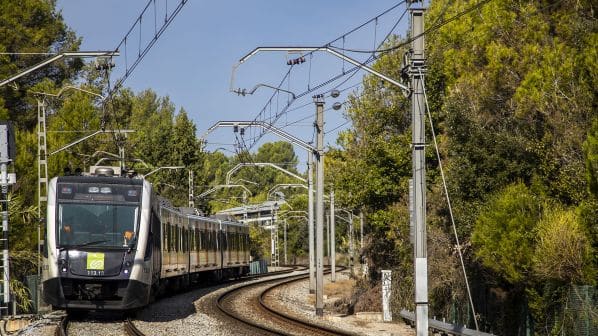HAVING led his organisation’s candidacy to co-host what organiser, the International Association of Public Transport (UITP), describes as the world’s biggest event dedicated to sustainable mobility, the president of Catalonia Government Railways (FGC), Mr Antoni Segarra, says that the timing of the event is fortuitous. “The congress comes at a crucial moment in our history as we prepare for future growth,” he says, pointing to a portfolio of strategic projects that “will allow us to double the number of passengers on FGC within the next 10 years.”
“We are very proud that Barcelona will become the world capital of public transport for a week, where operators from all over the world will share ideas and initiatives,” Segarra says. “It will be a magnificent opportunity to learn and, at the same time, to showcase our city and our country.”
“We also want delegates to experience first-hand our people-centred model, both from the customer’s perspective - our trains and stations are 100% accessible - and from the staff perspective, integrating the most advanced technologies to provide a high-quality service in terms of performance, efficiency and reliability.”
Preliminary work began last summer on one key major project, an underground extension of FGC’s 1000mm-gauge Llobregat-Anoia network from its current Barcelona city-centre terminus at Plaça Espanya to Gràcia, located on FGC’s 1435mm-gauge Vallès line to Terrassa and Sabadell.
“With an investment of over €400m, the project involves the construction of a new 4km tunnel and three new stations in an area of Barcelona that is currently not served by the metro network,” Segarra says. As well as improving the coverage of the public transport system in Barcelona, the project should also cut journey times for passengers.
Elsewhere, FGC has awarded a contract to undertake design studies for the first section of a new light rail network serving Tarragona, the second-largest city in Catalonia, which aims to increase the modal share of public transport in this area by up to 25% and involves initial investment of €150m. The planned 46km network with 47 stops will connect Tarragona and Reus with Vilaseca, Salou and Cambrils, serving Reus Airport, the port of Tarragona and mainline railway stations. FGC has launched tenders for a fleet of seven LRVs, with a maximum length of 40m and a minimum capacity of 210 passengers, which will deployed on the first phase of the network running between Vilaseca, Salou and Cambrils.
“We are very proud that Barcelona will become the world capital of public transport for a week, where operators from all over the world will share ideas and initiatives.”
Antoni Segarra, FGC president
FGC has also commissioned feasibility studies to analyse the viability of new light rail systems in four areas of Catalonia, some in major tourist areas such as the Costa Brava, which would add 280km of new routes. As well as new networks in the Terres de l’Ebre region and the Bages area, these include a line serving Girona Airport and a cross-border route to Andorra. FGC says that these projects stand to shape the future of public transport in Catalonia, serving new centres of activity.
At the outer ends of the Llobregat-Anoia network, FGC has tendered two projects to place the railway underground in the centres of Manresa and Igualada, creating new public space. Tenders have also been called for the construction of a new station to serve an industrial estate in Lleida, on the 89.8km 1668mm-gauge route from Lleida to La Pobla, where FGC took over train operations from national operator Renfe in 2016.
A fully accessible network
The Vallès line is now the busiest on the FGC network, with 57 million passenger-journeys recorded in 2022. At the end of last year, FGC brought into service 15 new four-car series 115 EMUs supplied by Stadler. “With these new trains, the fleet now comprises 61 EMUs, allowing us to increase the capacity of the line from 80 million to 110 million passengers per year,” Segarra says.
The new trains feature multi-functional spaces for passengers with reduced mobility, and all seats are equipped with USB connections for charging mobile devices and tablets. “On the Lleida - La Pobla line, we recently put into service a third train, which has allowed us to improve and reinforce service availability,” Segarra says. “We will also be introducing six new trains on the Manresa - Lleida regional line, currently operated by Renfe but to be taken over by FGC in 2025. This will double the capacity of the line, with trains running at twice the frequency.”
“We have been at the forefront in achieving full accessibility in our facilities, which we completed several years ago. Currently, the entire FGC network is adapted for people with reduced mobility. This includes the 81 stations of the metropolitan lines serving Barcelona, the 17 stations of the Lleida - La Pobla line, and the stations of our tourist train operations and funiculars. All our trains are also accessible and have multi-functional spaces for people with reduced mobility.

“Our efforts towards universal accessibility go beyond individuals with reduced mobility. We are also working to facilitate access for many other groups.” These initiatives have included adopting the NaviLens system, which enables visually-impaired passengers to determine their location within stations by scanning tags with their mobile phones.
Since September 2022, passengers have been able to use the T-Mobilitat digital contactless ticketing system at all 81 stations of the FGC metropolitan network. T-Mobilitat combines ease of use with passenger assistance and journey information functions, and is part of the integrated fares system for travel on all operators in the province of Barcelona that enables through ticketing with a single payment. T-Mobilitat is available at all ticket vending machines, and FGC station staff are equipped with tablets to process transactions immediately. The new FGC T-Mobilitat app enables users to register, purchase, recharge or exchange T-Mobilitat tickets, both in physical and electronic formats.
“We use the data provided by T-Mobilitat tickets to determine the type of demand on each of our lines,” Segarra says. “We also employ advanced anti-fare evasion systems, including the CCTV-based Detector system that generates real-time alerts when passengers do not validate their tickets at the fare gates.”
Growing the business
Traffic on the FGC network has not only recovered from the Covid-19 pandemic, but has already bounced back to exceed pre-pandemic levels. “In March 2023, there were 8.9 million journeys on FGC’s metropolitan lines, which is a 5.49% increase compared with March 2019,” Segarra reports. “This growth is higher than the overall increase in use of public transport in the Barcelona area, which saw a 3.5% increase in the same month.”
“Looking at the first quarter of 2023, the number of journeys is still slightly below the first quarter of 2019, being 1.2% down at FGC. However, the data from March gives us hope as it indicates that we are on the right track. Over the past two years following the pandemic, we have made a significant effort to first restore confidence in using public transport and then to improve service frequency and the travel experience with our new trains. The passenger numbers for 2023 make us happy and optimistic.”
The FGC network is set to grow further with a service from Barcelona to El Prat Airport, using the new 1668mm-gauge rail link to Terminal 1 that is being built by national rail infrastructure manager Adif and is expected to be completed by 2025. “FGC has already taken all the necessary steps to begin operating on the new line as soon as the infrastructure is ready,” Segarra reports. “The service will be operated with 10 new 85m-long trains, each with capacity for 600 people. They will be equipped with the most advanced safety systems and real-time flight and terminal information.”
FGC awarded Alstom a €177m contract, including maintenance over 15 years, to supply the 10 five-car trains which will enable passengers to reach both terminals 1 and 2 at El Prat from the centre of Barcelona in just 15 minutes. “The trains will have the specific features required for an airport service, such as ample luggage space and wider aisles,” Segarra says. The new fleet will also be built with materials having a recyclability rate of 96%.
“The new line will significantly reduce the journey time by train from Barcelona to the airport, while helping to relieve congestion on the road network by attracting private vehicle users,” Segarra says. “Currently, Terminal 1 has no direct rail connection to the centre of Barcelona, while Terminal 2 only has two services per hour.”
In addition to replacing Renfe on the Lleida - Manresa line in 2025, FGC’s operations on the national network are set to further expand. It is involved in one of the 10 cross-border pilot projects receiving support from the European Commission under an initiative announced on January 31, which would see new medium-distance high-speed services connecting Catalonia with Toulouse and Montpellier in France.
“It is an initiative that extends FGC beyond urban and suburban transport to position it as an agent of sustainable mobility and territorial competitiveness,” Segarra says.

